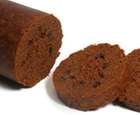|
New England Side Boston Brown Bread Slice large, thick slices and spread lavishly with butter. A perfect accompaniment for Boston Baked Beans.
Allow raisins to soak in boiling water till soft and plump. In a mixing bowl combine flour, cornmeal, baking soda and salt. In a separate bowl combine buttermilk with molasses and add this to flour. Don't over mix, stir just enough to moisten the flour. Add softened (drained) raisins. At this point you have 2 options for cooking Boston Brown Bread. 1) Steaming: the more traditional method. Use 3 standard 16-oz. clean vegetable cans; grease them well. Divide batter evenly between cans and cover tightly with heavy-duty foil. Tie a string around it to hold foil in place during steaming. Place cans on a rack in a large kettle. Pour boiling water in till it reaches 1/2 way up the sides of the cans. Cover kettle, bring to a gentle (not rolling) boil for 2 1/2 hours. Keep an extra pot of water boiling on the back stove and, if necessary, add boiling water to the kettle during steaming. Bread is done when a wooden skewer comes out clean. Remove cans from steam bath, cool slightly, and carefully remove bread. Cool 30 more minutes before slicing. 2) Baking: preheat oven to 350. Pour batter into 2 greased loaf pans. Bake 50-55 minutes, till a long wooden skewer comes out clean. Cool slightly before turning loaves out. Cool 30 more minutes before slicing. * You can also use a combination of 1 C white to 1 C whole-wheat, rye, or graham flour. | See more New England recipes |
|
Tips & Glossary Bouquet Garni: (boo-kay gar-nee), a bundle of herbs tied together with string or wrapped in cheese cloth square. Usual herbs include parsley, thyme, and bay leaf, and peppercorns. They release their flavor during long cooking. Used to flavor soups and stews and removed before serving. Ginger: dried ground ginger is far more potent than freshly grated from the root. Sweet dessert recipes call for ground powder. If you wish to use freshly grated ginger, use 6 times the amount of ground called for in the recipe. Nutmeg: Use small whole nuts and store them, tightly covered, in a dry dark area. Grate what you need using the smallest grating edge or grind in a food processor. What a difference from store bought nutmeg! Piecrust: Store-bought versions are heaven-sent for those who have neither the time nor the know-how for good homemade piecrust. But for those willing to make their own, the payoff is great. See our recipe for Noel's Pie Crust.
|

